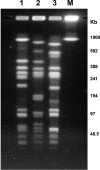Inducible clindamycin resistance and molecular epidemiologic trends of pediatric community-acquired methicillin-resistant Staphylococcus aureus in Dallas, Texas
- PMID: 15917522
- PMCID: PMC1140519
- DOI: 10.1128/AAC.49.6.2283-2288.2005
Inducible clindamycin resistance and molecular epidemiologic trends of pediatric community-acquired methicillin-resistant Staphylococcus aureus in Dallas, Texas
Abstract
Community-acquired methicillin-resistant Staphylococcus aureus (CA-MRSA) infection occurs commonly in children. Clindamycin resistance may be inducible or constitutive, and the rates of inducible resistance in CA-MRSA that could produce clindamycin treatment failures vary worldwide. The double-disk test was performed in 197 erythromycin-resistant and clindamycin-susceptible CA-MRSA strains from children in Dallas, Texas, from 1999 to 2002 to determine inducible clindamycin resistance. Resistance mechanisms were studied by PCR; epidemiologic trends were studied by pulsed-field gel electrophoresis (PFGE) and multilocus sequence typing (MLST). Inducible resistance was demonstrated in 28 (93%+/-6%) of 30 tested isolates in 1999, 21 (64%, +/-11%) of 33 in 2000, 12 (23%+/-7%) of 52 in 2001, and 6 (7%+/-3%) of 82 in 2002. All noninducible strains had the msr(A) gene. Among inducible resistant strains, 31 had erm(B), 24 had erm(C), and 12 had erm(A) genes. Two distinct pulsed types were the most prevalent; one of them was the most common pulsed type in 1999, whereas in 2002 a different pulsed type was prevalent. MLST analyses determined that ST-8 was the most common type, with 76%+/-5% found in 2002. All but one of these clindamycin-susceptible, erythromycin-resistant ST-8 strains showed no induction of clindamycin resistance. We conclude that, among erythromycin-resistant, clindamycin-susceptible CA-MRSA strains isolated from children in Dallas, inducible methylase resistance became less common from 1999 to 2002 (P<0.001). The phenotype of strains was associated with their sequence type. Our results demonstrate a clonal shift in CA-MRSA in Dallas children from 1999 to 2002.
Figures



Similar articles
-
Comparisons of community-associated methicillin-resistant Staphylococcus aureus (MRSA) and hospital-associated MSRA infections in Sacramento, California.J Clin Microbiol. 2006 Jul;44(7):2423-7. doi: 10.1128/JCM.00254-06. J Clin Microbiol. 2006. PMID: 16825359 Free PMC article.
-
Epidemiology and molecular characteristics of community-associated methicillin-resistant and methicillin-susceptible Staphylococcus aureus from skin/soft tissue infections in a children's hospital in Beijing, China.Diagn Microbiol Infect Dis. 2010 May;67(1):1-8. doi: 10.1016/j.diagmicrobio.2009.12.006. Epub 2010 Mar 12. Diagn Microbiol Infect Dis. 2010. PMID: 20227225
-
Molecular epidemiology of community-associated antimicrobial-resistant Staphylococcus aureus in Seoul, Korea (2003): pervasiveness of multidrug-resistant SCCmec type II methicillin-resistant S. aureus.Microb Drug Resist. 2007 Fall;13(3):178-85. doi: 10.1089/mdr.2007.709. Microb Drug Resist. 2007. PMID: 17949304
-
Treatment of community-acquired methicillin-resistant Staphylococcus aureus in children.Curr Opin Infect Dis. 2003 Jun;16(3):265-9. doi: 10.1097/00001432-200306000-00014. Curr Opin Infect Dis. 2003. PMID: 12821819 Review.
-
Community-acquired MRSA in children.Paediatr Nurs. 2003 Mar;15(2):47-51. doi: 10.7748/paed2003.03.15.2.47.c841. Paediatr Nurs. 2003. PMID: 12677860 Review. No abstract available.
Cited by
-
A Low Prevalence of Inducible Macrolide, Lincosamide, and Streptogramin B Resistance Phenotype among Methicillin-Susceptible Staphylococcus aureus Isolated from Malaysian Patients and Healthy Individuals.Jundishapur J Microbiol. 2016 Sep 10;9(10):e37148. doi: 10.5812/jjm.37148. eCollection 2016 Oct. Jundishapur J Microbiol. 2016. PMID: 27942364 Free PMC article.
-
Community-associated meticillin-resistant Staphylococcus aureus infections: epidemiology, recognition and management.Drugs. 2009;69(6):693-716. doi: 10.2165/00003495-200969060-00004. Drugs. 2009. PMID: 19405550 Review.
-
Treatment of Methicillin-Resistant Staphylococcus aureus (MRSA) Infections in Children: a Reappraisal of Vancomycin.Curr Infect Dis Rep. 2019 Sep 5;21(10):37. doi: 10.1007/s11908-019-0695-4. Curr Infect Dis Rep. 2019. PMID: 31486979 Review.
-
Microbiological Features of Upper Respiratory Tract Infections in Bulgarian Children for the Period 1998-2014.Balkan Med J. 2016 Nov;33(6):675-680. doi: 10.5152/balkanmedj.2016.150116. Epub 2016 Nov 1. Balkan Med J. 2016. PMID: 27994923 Free PMC article.
-
Ways to Improve Insights into Clindamycin Pharmacology and Pharmacokinetics Tailored to Practice.Antibiotics (Basel). 2022 May 21;11(5):701. doi: 10.3390/antibiotics11050701. Antibiotics (Basel). 2022. PMID: 35625345 Free PMC article. Review.
References
-
- Abi-Hanna, P., A. L. Frank, J. P. Quinn, S. Kelkar, P. C. Schreckenberger, M. K. Hayden, and J. F. Marcinak. 2000. Clonal features of community-acquired methicillin-resistant Staphylococcus aureus in children. Clin. Infect. Dis. 30:630-631. - PubMed
-
- Almer, L. S., V. D. Shortridge, A. M. Nilius, J. M. Beyer, N. B. Soni, M. H. Bui, G. G. Stone, and R. K. Flamm. 2002. Antimicrobial susceptibility and molecular characterization of community-acquired methicillin-resistant Staphylococcus aureus. Diagn. Microbiol. Infect. Dis. 43:225-232. - PubMed
-
- Avalos Mishaan, A. M., E. O. Mason, G. Martinez-Aguilar, W. Hammerman, J. J. Propst, J. R. Lupski, P. Stankiewicz, S. L. Kaplan, and K. Hulten. 2005. Emergence of a predominant clone of community-acquired Staphylococcus aureus among children in Houston, Texas. Pediatr. Infect. Dis. J. 24:201-206. - PubMed
-
- Baba, T., F. Takeuchi, M. Kuroda, H. Yuzawa, K. Aoki, A. Oguchi, Y. Nagai, N. Iwama, K. Asano, T. Naimi, H. Kuroda, L. Cui, K. Yamamoto, and K. Hiramatsu. 2002. Genome and virulence determinants of high virulence community-acquired MRSA. Lancet 359:1819-1827. - PubMed
-
- Buckingham, S. C., L. K. McDougal, L. D. Cathey, K. Comeaux, A. S. Craig, S. K. Fridkin, and F. C. Tenover. 2004. Emergence of community-associated methicillin-resistant Staphylococcus aureus at a Memphis, Tennessee Children's Hospital. Pediatr. Infect. Dis. J. 23:619-624. - PubMed
MeSH terms
Substances
LinkOut - more resources
Full Text Sources
Medical

